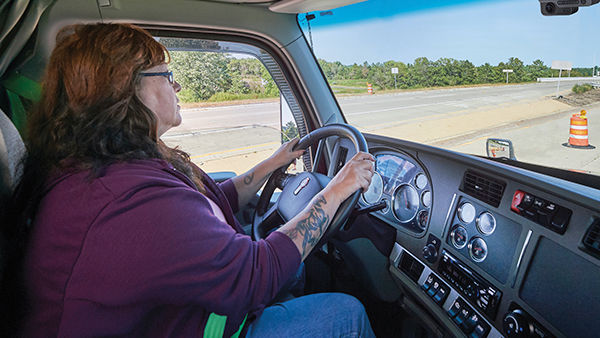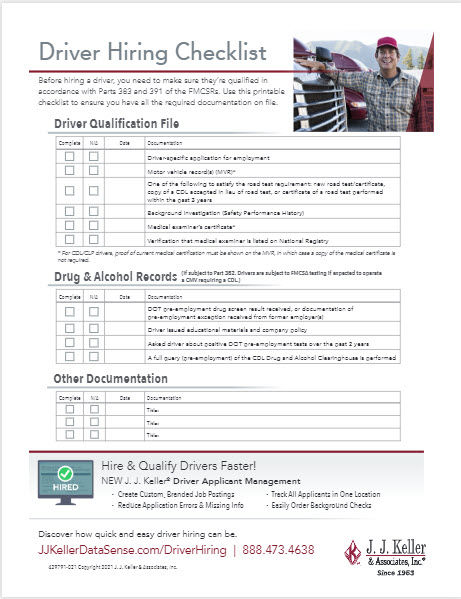Before hiring a driver, you need to make sure they're qualified in accordance with Part 383 and 391 of the FMCSRs. Use this printable checklist to ensure you have all required documentation on file.
What Needs to Be in a New Driver's File?
Kathy Close, Editor - Transport, Safety
January 13, 2021

Onboarding a new driver requires putting a system in place to ensure everything is complete — and completed on time.
Putting an unqualified driver, even inadvertently, behind the wheel of your commercial motor vehicle (CMV) opens your carrier up to fines in the event of an audit and nuclear verdicts if the driver is involved in a high-profile crash.
The use of a new hire checklist is one means of ensuring no detail is missed. Provided below are areas to include in your new hire to-do list.
Documents needed before operating a CMV
You must assemble specific driver qualification documents on new hires and those transferring into a driving position before assigning them to a CMV, including:
Driver-specific application
The form must contain the required data elements in §391.21. It can be hardcopy or electronic. An online version may be used as long as the electronic signature meets the federal definition. In other words, you have to be able to verify the driver's identity (e.g., username/password, script using stylus, mouse, or finger) and show the applicant saw everything he or she was attesting to.
Road test and certificate
A road test must be performed in accordance with §391.31 using the vehicle type you intend on assigning the driver. You could also collect documentation showing the driver qualifies for one of the following two exceptions in §391.31:
- Copy of a commercial drivers' license (CDL); or
- Copy of a road test certificate for a test performed within the past three years on a representative vehicle. (See FMCSA D & A recordkeeping below for more on road tests.)
Proof of medical certificate
The type of documentation you need is based on the driver's licensing. For a non-CDL driver, it is a copy of the medical examiner's certificate (MEC) and any exemption, if applicable. For a CDL driver, proof is determined on how long ago the exam was performed. You would use a copy of a recent MEC, if issued within the past 15 days ago, you must request an MVR showing this most recent exam. And, as with the non-CDL driver, you would need a copy of any applicable exemption.
NRCME verification
ou must create a note that you verified that the medical examiner (ME) appeared on the National Registry of Certified Medical Examiners (NRCME) on the date of the exam.
Proof of entry-level driver training
If a CDL driver is subject to the entry-level driver training in Part 380, you must obtain a copy of his or her certificate or diploma.
In addition, you must verify the driver has available hours on his or her first day based on hours-of-service limits. The driver must provide a signed statement giving:
- The total time on duty during the immediately preceding seven days, and
- The time at which the driver was last relieved from duty prior to beginning work for the motor carrier.
For drivers subject to the Federal Motor Carrier Safety Administration (FMCSA) Part 382 testing, you need some additional items before operating a CMV, such as:
Pre-employment test result or proof of the exception
The motor carrier must have a verified negative pre-employment drug test or documentation (in hand) that the driver meets the pre-employment exception in §382.301(b). Note that FMCSA has indicated you can perform a road test, provided it is not a dispatch, prior to the pre-employment drug test result.
Pre-employment query
A pre-employment query of the CDL Drug & Alcohol Clearinghouse is a needed before you take the driver out for his or her road test. If you use one of the exceptions to the road test in §391.33, you will need the query before the first dispatch. The Clearinghouse will alert you to any changes to the driver's record within 30 days of the pre-employment query, and you would have to follow-up with another full query to learn details.
DOT D&A policy receipt
Before a driver participates in your Part 382 program, you must provide him or her with a copy of your policy and educational materials. Performing a safety-sensitive function is participating in your program, even if the random pull is weeks or months away. The driver must sign a receipt showing that he or she received a copy of materials.
Previous pre-employment test violation
You must ask the driver whether he or she tested positive or refused a DOT pre-employment test in the past two years and was not hired (§40.25(j)). Even though DOT does not specify the timeline to ask this question, it is best to get it out of the way before performing a safety-sensitive function, since it is open to interpretation.
Items needed shortly after hire
The motor carrier has a little more time to assemble specific new driver documents. Examples include:
Safety performance history records request
Within 30 days of hire, you must have returned inquiries or more than one documented attempt at getting the information. If a driver does not have any safety performance history to report in the past three years, you would document that fact in lieu of the history. This requirement applies to both CDL and non-CDL CMV drivers.
Initial MVR
For non-CDL drivers, you have 30 days to request the initial MVR from each state in which the driver was licensed in the past three years. For a CDL driver, the MVR will be needed earlier, depending on when the medical exam was performed. This MVR is used as both proof of medical certification and initial MVR.
Signed consent for the first annual Clearinghouse query
Many carriers have their CDL-positioned drivers sign a consent for annual queries that is valid for the duration of employment. It is often easier to have the driver sign the paperwork as a part of new hire orientation, rather than at the one-year anniversary when it is due.
Assigning roles
With so many details and deadlines when filling driving positions, it is important to make sure someone is tracking and assembling documents. Without oversight, you may find yourself with an unqualified driver — and the risk associated with allowing him or her to operate your CMV.
FREE Driver Hiring Checklist & Quote
